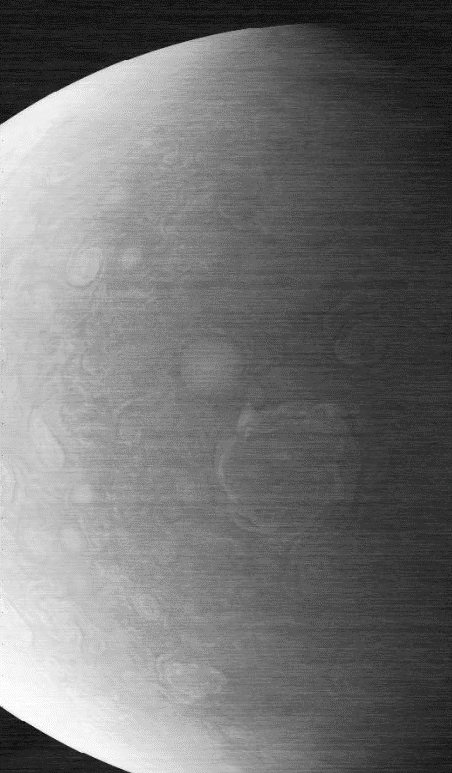
As a photographer, I’ve known the horror of opening images to find them corrupted – but I imagine that feeling pales in comparison to what NASA felt when Juno, a spacecraft orbiting Jupiter 370 million miles away, began returning corrupted images from a radiation-fried camera.
Launching another camera isn’t exactly an option, considering the total costs of the Juno spacecraft and mission sit a $1.13 billion, and it’s not like there’s a camera repair shop on Jupiter.
So what did NASA do? NASA took a risk and intentionally overheated the camera in an attempt to save it.
Juno, a spacecraft studying Jupiter, successfully completed its primary mission in 34 orbits. But as the spacecraft continued to study the planet, around the 47th orbit, the images that Juno sent back were beginning to show signs of sensor damage. Nine orbits later, and nearly all of the images that Juno was sending back were corrupted, with lines running through the images and more graininess than normal.

NASA scientists theorized that the damage was due to radiation. JunoCam – which is a color, visible light camera – is housed in a “radiation vault” lined with titanium, NASA says, but Jupiter has some of the most intense radiation in the Solar System. Essentially, that camera is traveling through radiation as strong as 100 million X-rays.
Based on clues, NASA researchers believed that the damage to the camera was in a voltage regulator. But how do you repair a component integral to a camera’s power supply from 370 million miles away?
NASA turned to a little-understood process called annealing, a procedure for heating up a material for a certain length of time, then allowing it to cool. Annealing has been shown to alter materials like silicone, an essential component in a camera’s sensor and electronics.
“We knew annealing can sometimes alter a material like silicon at a microscopic level but didn’t know if this would fix the damage,” Jacob Schaffner, a JunoCam engineer from Malin Space Science Systems in San Diego, said. “We commanded JunoCam’s one heater to raise the camera’s temperature to 77 degrees Fahrenheit — much warmer than typical for JunoCam — and waited with bated breath to see the results.”
After overheating the camera, JunoCam began sending back cleaner images. But after a few more orbits, continuing to venture further into the radiation with each pass, the images began returning with defects once again.
No amount of post-processing was able to recover the data, Michael Ravine, the JunoCam Instrument Lead, said, but Juno was due to orbit near the moon Io at the time. The team, keen to photograph one of Jupiter’s moons and continue gathering visual data from the mission, tried one more thing. “With the close encounter of Io bearing down on us in a few weeks, it was Hail Mary time: The only thing left we hadn’t tried was to crank JunoCam’s heater all the way up and see if more extreme annealing would save us,” Ravine said.
Test images showed improvement after the first week, then, finally, as Juno was making its close approach to Io, the camera returned images nearly as good as the day the spacecraft’s first images were taken, allowing researchers to capture images of Io.
Io is one of 95 moons on Jupiter, but NASA says the moon is the most volcanically active space in the solar system. Repairing the camera allowed Juno to photograph the volcanoes dotting the surface.
This Hail Mary move happened in December of 2023, but NASA recently presented the data at an engineering conference earlier this month. Since using the process to repair Juno’s camera, the team has also used it to repair other components aboard Juno. The team expects that the process could be used to maintain spacecraft as well as satellites in the future.
Juno has now orbited Jupiter 74 times and is beginning to show signs of further radiation damage. But, the annealing allowed researchers to catch a glimpse of the moon Io and continue photographing the planet. Not bad for long-distance camera repair.
You may also like
Browse the best lenses for astrophotography or take a look at DCW's top picks for the best tripods.







